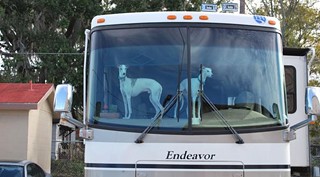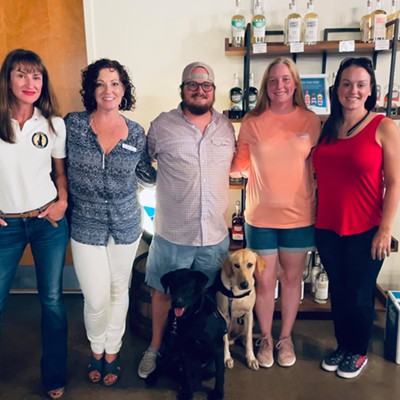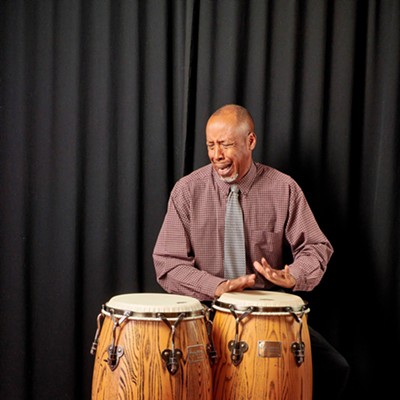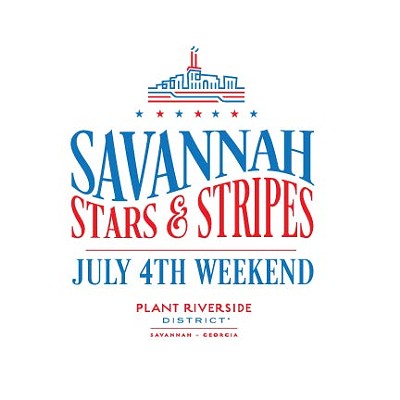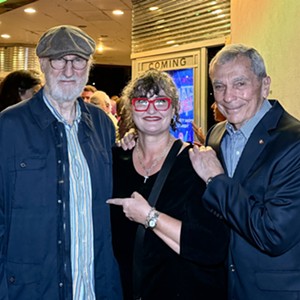To the uninitiated, the first visit to the dog show is surreal. In the parking lot, a man in a tweed jacket holds a lopsided conversation with a border collie. A woman in a golf cart cruises past; sitting next to her is a dalmatian with excellent posture. There are greyhounds wearing sweaters with a Southwestern motif. It's as close as a person can get to inhabiting one of those C.M. Coolidge paintings of the dogs playing poker.
For four days, the Savannah Kennel Club and the Beaufort Kennel Club host this annual event that is "like Westminster, only smaller because it's not in Madison Square Garden," explains SKC President and Show Chairman Kelly Meyer.
More than 1,000 dogs arrived to compete and many attendees have driven hundreds, and in some cases thousands of miles.
"We normally have dogs from just about every state," Meyer says.
The parking lot is full of several rows of RVs and campers housing the dog show diehards. Those give way to vans, trucks and cars of daytrippers and locals. Temporary pens and wire crates are scattered throughout the parking lot, many next to portable grooming tables.
The competitive side of the dog show world is something like NASCAR or professional tennis. There are lots of dogs competing, but few ever make it to the highest level. First, a dog must be a champion, a status achieved by accumulating a certain amount of points in breed-specific competitions. After becoming a champion, every win at an American Kennel Club sanctioned show adds points to their total. The animals with the most points are considered to be top dog in their breed nationally, and earn invitations to events like Westminster.
Thursday morning in Savannah is a long way from the hallowed company of Westminster victors. It's like tryouts for the big game - dogs who are working to earn enough points to make it to champion status. With each day that passes there will be less dogs in the running for group titles.
"They're competing for these ribbons," says Meyer holding up a pair of the awards stamped with gold lettering and an AKC logo. "These are points."
There is a strange mix of competitive spirit and genuine love amongst the owners, similar to the emotion at pageants and similar contests testing physique and manners of dependent creatures like pets or children.
Reiterated several times is the point that the dog show is not a beauty pageant - dogs are judged according to published breed standards maintained by the AKC, not by looks alone. Judges are supposed to select the dog that conforms best to the published standards for its breed. But even with those guidelines, many people still say that it all comes down to some luck and the judge - sometimes you get one that likes your dog, and sometimes you don't.
While economics plays a part in any pursuit requiring this investment of time and money, it's clear that most people are too passionate to consider this a job. The only way to endure the long days, travel and hard work that fills the space between trips into the ring for competition is to care deeply about the animals.
"We do it for the love of dogs," says Meyer.
There's little question of who's in charge. Amongst the dog community, owners are less often recognized than their animals. A commonly heard moment of recognition during conversation sounds like "oh, your dog is (insert name)!"
"I learn the dogs' names before the owners' names," says Becky Smith, a local photographer specializing in "fine pet portraiture," who has several clients competing in the show.
Learning dog names is a two-part process, particularly for show dogs. Often times dogs have a call name - something short they respond to - and a full name, which is usually long and unwieldy. For example, a handsome six-year old Doberman called Gaston's full name was "Paws-a-tively Splenda Machine."
Despite the formality and convention that pervades most aspects of showing dogs professionally, there is still an undercurrent of self-effacing humor to be found (albeit mildly antiquated). One bumper sticker reads: "Don't tell my mother I'm a dog handler! She thinks I play the piano in a whorehouse."
The tone of the dog show has changed substantially by Saturday afternoon. There are hundreds more people, and fewer dogs. Groups are competing now - hound, toy, etc. - and there are an ark-worthy variety of breeds mingling. A bulldog, a dachshund and some smaller iteration of a spaniel are all standing around looking at each other while their handlers talk. Nearly all the animals have no problem with the crowds or the steady stream of foot traffic.
Discussions amongst attendees have switched from topics like parking, travel arrangements and evening tours of the city, and are now focused on rankings, deal brokering and surprise winners.
After three days sitting by the entrance to the main building, working on everything from selling the bound editions of the show's catalogue (a list of all the competitors and categories) to arranging sewage pump-outs for the RVs (who've now been parked on the premises since Wednesday afternoon), Kelly Meyer has a quiet moment to survey the crowd and two simultaneous groups showing.
"It's nice to see this all come together," she says.
Months of planning and organizing, including help from dozens of volunteers over the last few days has paid off. Putting on a show is a raison d'etre for a local kennel club, a way of maintaining both community and tradition.
"It's how we pay back," says Meyer. "If members weren't willing to work at least once a year for a show then there wouldn't be any shows so we wouldn't be able to go anywhere."

